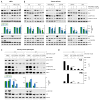MNK Controls mTORC1:Substrate Association through Regulation of TELO2 Binding with mTORC1
- PMID: 28178522
- PMCID: PMC5321627
- DOI: 10.1016/j.celrep.2017.01.023
MNK Controls mTORC1:Substrate Association through Regulation of TELO2 Binding with mTORC1
Abstract
The mechanistic target of rapamycin (mTOR) integrates numerous stimuli and coordinates the adaptive response of many cellular processes. To accomplish this, mTOR associates with distinct co-factors that determine its signaling output. While many of these co-factors are known, in many cases their function and regulation remain opaque. The MAPK-interacting kinase (MNK) contributes to rapamycin resistance in cancer cells. Here, we demonstrate that MNK sustains mTORC1 activity following rapamycin treatment and contributes to mTORC1 signaling following T cell activation and growth stimuli in cancer cells. We determine that MNK engages with mTORC1, promotes mTORC1 association with the phosphatidyl inositol 3' kinase-related kinase (PIKK) stabilizer, TELO2, and facilitates mTORC1:substrate binding. Moreover, our data suggest that DEPTOR, the endogenous inhibitor of mTOR, opposes mTORC1:substrate association by preventing TELO2:mTORC1 binding. Thus, MNK orchestrates counterbalancing forces that regulate mTORC1 enzymatic activity.
Keywords: DDB1; DEPTOR; MNK; PIKK; S6 kinase; T cell; TELO2; mTOR; rapamycin; raptor.
Copyright © 2017 The Author(s). Published by Elsevier Inc. All rights reserved.
Figures







Similar articles
-
Simultaneous inhibition of mTOR-containing complex 1 (mTORC1) and MNK induces apoptosis of cutaneous T-cell lymphoma (CTCL) cells.PLoS One. 2011;6(9):e24849. doi: 10.1371/journal.pone.0024849. Epub 2011 Sep 16. PLoS One. 2011. Retraction in: PLoS One. 2020 Sep 10;15(9):e0239102. doi: 10.1371/journal.pone.0239102. PMID: 21949767 Free PMC article. Retracted.
-
MNK inversely regulates TELO2 vs. DEPTOR to control mTORC1 signaling.Mol Cell Oncol. 2017 Mar 17;4(3):e1306010. doi: 10.1080/23723556.2017.1306010. eCollection 2017. Mol Cell Oncol. 2017. PMID: 28616583 Free PMC article.
-
The role of MNK1-mTORC1 pathway in modulating macrophage responses to Vibrio vulnificus infection.Microbiol Spectr. 2024 Aug 6;12(8):e0334023. doi: 10.1128/spectrum.03340-23. Epub 2024 Jul 9. Microbiol Spectr. 2024. PMID: 38980024 Free PMC article.
-
Discrete signaling mechanisms of mTORC1 and mTORC2: Connected yet apart in cellular and molecular aspects.Adv Biol Regul. 2017 May;64:39-48. doi: 10.1016/j.jbior.2016.12.001. Epub 2017 Jan 4. Adv Biol Regul. 2017. PMID: 28189457 Review.
-
The Role of Mammalian Target of Rapamycin (mTOR) in Insulin Signaling.Nutrients. 2017 Oct 27;9(11):1176. doi: 10.3390/nu9111176. Nutrients. 2017. PMID: 29077002 Free PMC article. Review.
Cited by
-
Metformin blocks MYC protein synthesis in colorectal cancer via mTOR-4EBP-eIF4E and MNK1-eIF4G-eIF4E signaling.Mol Oncol. 2018 Nov;12(11):1856-1870. doi: 10.1002/1878-0261.12384. Epub 2018 Oct 15. Mol Oncol. 2018. PMID: 30221473 Free PMC article.
-
Deeping in the Role of the MAP-Kinases Interacting Kinases (MNKs) in Cancer.Int J Mol Sci. 2020 Apr 23;21(8):2967. doi: 10.3390/ijms21082967. Int J Mol Sci. 2020. PMID: 32340135 Free PMC article. Review.
-
Exploring the Functional Roles of Telomere Maintenance 2 in the Tumorigenesis of Glioblastoma Multiforme and Drug Responsiveness to Temozolomide.Int J Mol Sci. 2023 May 25;24(11):9256. doi: 10.3390/ijms24119256. Int J Mol Sci. 2023. PMID: 37298208 Free PMC article.
-
Inhibitory effects of Tomivosertib in acute myeloid leukemia.Oncotarget. 2021 May 11;12(10):955-966. doi: 10.18632/oncotarget.27952. eCollection 2021 May 11. Oncotarget. 2021. PMID: 34012509 Free PMC article.
-
Maturation and Assembly of mTOR Complexes by the HSP90-R2TP-TTT Chaperone System: Molecular Insights and Mechanisms.Subcell Biochem. 2024;104:459-483. doi: 10.1007/978-3-031-58843-3_17. Subcell Biochem. 2024. PMID: 38963496 Review.
References
-
- Adesso L, Calabretta S, Barbagallo F, Capurso G, Pilozzi E, Geremia R, Delle Fave G, Sette C. Gemcitabine triggers a pro-survival response in pancreatic cancer cells through activation of the MNK2/eIF4E pathway. Oncogene. 2013;32:2848–2857. - PubMed
-
- Brown MC, Bryant JD, Dobrikova EY, Shveygert M, Bradrick SS, Chandramohan V, Bigner DD, Gromeier M. Induction of viral, 7-methyl-guanosine cap-independent translation and oncolysis by mitogen-activated protein kinase-interacting kinase-mediated effects on the serine/arginine-rich protein kinase. J Virol. 2014a;88:13135–13148. - PMC - PubMed
-
- Brown MC, Dobrikov MI, Gromeier M. Mitogen-activated protein kinase-interacting kinase regulates mTOR/AKT signaling and controls the serine/arginine-rich protein kinase-responsive type 1 internal ribosome entry site-mediated translation and viral oncolysis. J Virol. 2014b;88:13149–13160. - PMC - PubMed
-
- Chrestensen CA, Eschenroeder A, Ross WG, Ueda T, Watanabe-Fukunaga R, Fukunaga R, Sturgill TW. Loss of MNK function sensitizes fibroblasts to serum-withdrawal induced apoptosis. Genes to cells : devoted to molecular & cellular mechanisms. 2007;12:1133–1140. - PubMed
MeSH terms
Substances
Grants and funding
LinkOut - more resources
Full Text Sources
Other Literature Sources
Molecular Biology Databases
Research Materials
Miscellaneous

